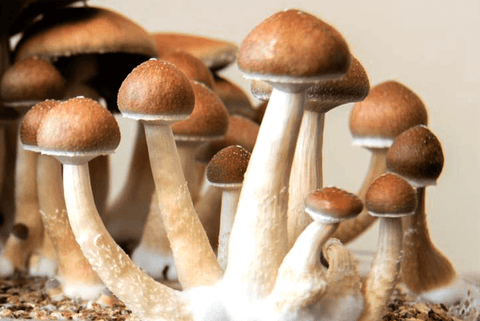Magic mushrooms are popular for a range of reasons — concentration enhancements, sensory distortion, euphoria, and more. But what makes these shrooms so magical?
Psilocybin is a hallucinogenic chemical found naturally in various mushroom species throughout the United States of America, South America, Mexico, and Europe. It's the ingredient that rewires your brain and quite literally puts the magic in magic mushrooms.
In this article, we'll explore psilocybin in more detail, including how it works in the body and the subsequent effects.
What Is Psilocybin?
Psilocybin is a psychoactive compound occurring naturally in over 180 mushrooms all over the world. When ingested, it produces psychedelic or hallucinogenic effects.
Interestingly, every shroom can have different psychedelic impacts. So, even though the effects are always brought about by psilocybin, sources state that scientists are still researching the reasons for this phenomenon.
As you can see, the description of psilocybin is rather simple. However, it's how it works that's the most exciting part.

How Does Psilocybin Work? (The Science Bit)
The chemical works by activating your brain's serotonin receptors, which are commonly found in the prefrontal cortex. These receptors are responsible for your mood, perception, and cognition, but they aren't the only place affected by this hallucinogen.
Psilocybin also works in other regions of your brain that deal with panic responses and arousal.
However, it's only once your body converts psilocybin into psilocin that the psychoactive effects occur. You won't have to wait too long for this, though, as the process begins upon ingestion.
According to anecdotal evidence, the chemical's hallucinogenic effects take place within half an hour of ingesting it, lasting for around four to six hours. Although, some people have mentioned that their thought patterns and sensory perception changed for several days following consumption!
Depending on the potency (we'll get into that in a moment), psilocybin won't always create active auditory or visual hallucinations. Instead, it alters your perception of the real-life objects or people around you.
Ultimately, the amount you take, how you expect the experience to go, and your past experiences will dictate the extent to which psilocybin affects you.

Source: Pyschedelic Review
Psilocybin and Psilocin: The Super Science-y Bit
Both compounds are psychedelic tryptamines which are molecularly similar to serotonin. It's this near-equal structure that allows them to activate the aforementioned serotonin receptors.
But let's dig a little deeper.
Psilocybin and psilocin target a particular serotonin receptor site called 5HT2A. This area regulates a range of functions, including imagination, mood, perception, and learning.
Most of 5HT2A's receptors sit in the cortex, which is largely associated with rational thought and reasoning. This region spans a much bigger area than most other sections of the brain. Thus, manipulating the receptors here boasts more of an impact.
Per more recent research, psilocin also affects the Default Mode Network or DMN, another area of the brain.
Consider the DMN your brain's main information transmission pathways. They consolidate and compile information as you live your life, giving you the ability to remember events and plan future ones.
Moreover, some people suggest the Default Mode Network is the place where your "self" resides, that is, your individuality.
Psilocin temporarily disables at least one of the "hubs" found in your DMN. The shutdown means your brain won't connect to the same parts as normal. Thus, it's forced to rewire and share information to sections it wouldn't usually communicate with.
Granted, scientists' understandings of exactly how psilocin does this aren't complete. Therefore, research is always continuing.
Let's Talk Potency
As alluded to earlier, there are loads of psilocybin-containing mushrooms out there. But Mother Nature didn't create them all equally — some contain more of the psychoactive compound than others. Therefore, some magic mushrooms are more "magic" than their counterparts.
A mushroom's potency is measured by the amount of psilocybin and psilocin it has. Typically, it's calculated as a percentage of the dry weight or in milligrams.
For example, the most popular shroom species is Psilocybe cubensis. If one gram of the mushroom contains 0.5% psilocybin by dry weight, it has 5mg or 0.005g of the chemical.
That said, lots of factors affect mushroom potency, including:
- Preparation — Whether the mushrooms are ground, brewed, or fresh will determine the potency and absorption rate.
- Growing conditions — Nature and nurture when growing affects mushrooms' potencies. Those purposefully cultivated indoors or in certain substrates likely contain more psilocybin than shrooms left to their own devices.
- Medication — Since the chemical impacts the brain, mixing psilocybin with other medications alters its potency, especially if the drugs are for mental health problems.
- Biology and psychology — Everybody responds to psilocybin differently, so independent biology and psychology will change how you respond. According to a 2012 study, people with lower stress levels and who are more emotionally excited before ingestion are the most able to have a pleasant psilocybin experience.
- Mushroom species — As we've already mentioned, the species plays a huge role in potency. Generally, P. azurescens tends to be stronger than the most popular cubensis.
Curious About More Mushroom Effects?
Psilocybin produces a range of mood-, perception-, and sensory-related effects known in the avid shroom community as the "trip." Purportedly, nature becomes more beautiful, music is more intense, and the mind opens.
While we don't offer Psilocybin based products, we do offer Amanitas. For similar effects, browse our mighty collection of tinctures, capsules, cookies, gummies, and dusts. We follow strict protocols when processing our Amanita mushroom products, minimizing risks and dangers.
References
https://www.medicalnewstoday.com/articles/30885
https://www.drugscience.org.uk/drug-information/psilocybin/#1612864173718-9259e640-59e5
https://doubleblindmag.com/mushrooms/how-to-take-shrooms/mushroom-dosage/

